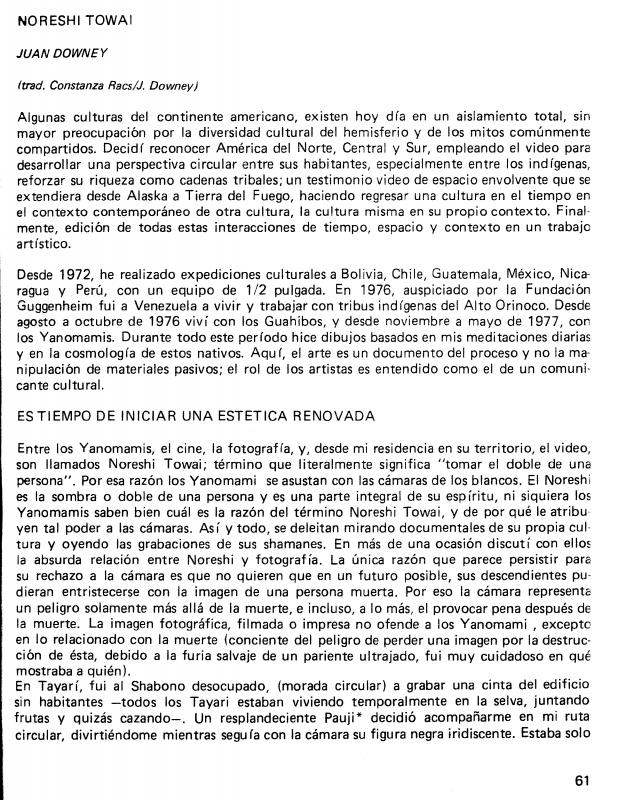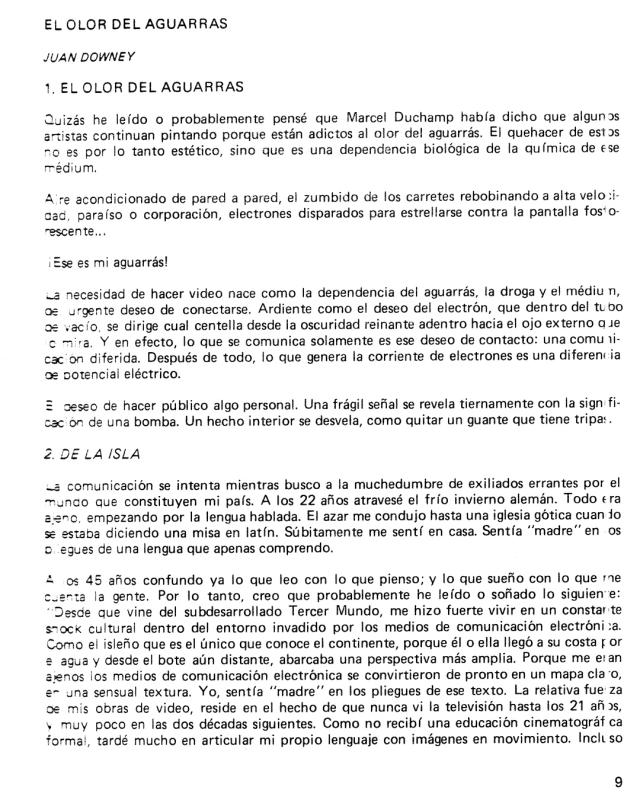This document, about the artist Juan Downey (1940–1993), appeared in the catalogue for the exhibition IN/OUT: Four Projects by Chilean Artists, which was presented in 1983 at the Washington Project for the Arts in Washington, D.C. The exhibition also included works by Eugenio Dittborn (b. 1943), the art action group known as CADA (Colectivo de Acciones de Arte, 1979–85), and Alfredo Jaar (b. 1956). [On the subject of the CADA group’s participation, see the following in the ICAA Digital Archive: “Residuos americanos / CADA” (doc. no. 747333) jointly written by the members of the group].
According to the document in question, the two videos shown on that occasion were The Laughing Alligator (1979) and The Looking Glass (1981). The first of these was shot while the artist and his family were living with the Yanomami peoples in the Amazon region located between Venezuela and Brazil. The resulting video created tension between a biographical and an anthropological approach, since Downey’s way of exploring his host’s culture, rituals, myths, and ceremonies differed from a (neutral and objective) scientific treatment, which he imitated by filming the sort of scenes usually shown in ethnographic research documentaries. Downey wanted to explore his own cultural identity through the prism of his status as a third-world artist. In “Noreshi Towai” (doc. no. 735718) he describes being involved in the Yanomami’s endocannibalism practices during their funeral ceremonies. In “El olor del aguarrás” (doc. no 735687), an essay he wrote in 1987, he refers to videos of this kind as “open” (or failed) since he was unable to achieve his objective of understanding his personal connection to those places. The Looking Glass was the first video in the series called The Thinking Eye, which was filmed in England, France, Spain and, obviously, New York. Here he explores the idea of a “mirror” as a reflection of the subconscious as it relates to narcissism. The video includes several scenes of mirrors that appear in artworks such as Portrait of Giovanni Arnolfini and his Wife (1434) by Jan Van Eyck (c.1390–1441); The Ambassadors (1533) by Hans Holbein (c.1497–1543), and Las Meninas (1656) by Diego de Velázquez (1599–1660). In his video, Downey is shown talking in front of a TV set where his image also appears, thus using technology to create a “frame within a frame” that explores television as a genre in an audiovisual essay that suggests multiple readings. The historian John Hanhardt discusses this in his essay “Reelaborando la modernidad de Juan Downey en The Thinking Eye” (doc. no. 739203), in which he reviews the series and one of Downey’s last videos Hard Times and Culture, Part One, Vienna “Fin de Siècle” (1990). [For more information about this video, see: “Nueva York, abril 1990” (doc. no. 745642) by the artist].




